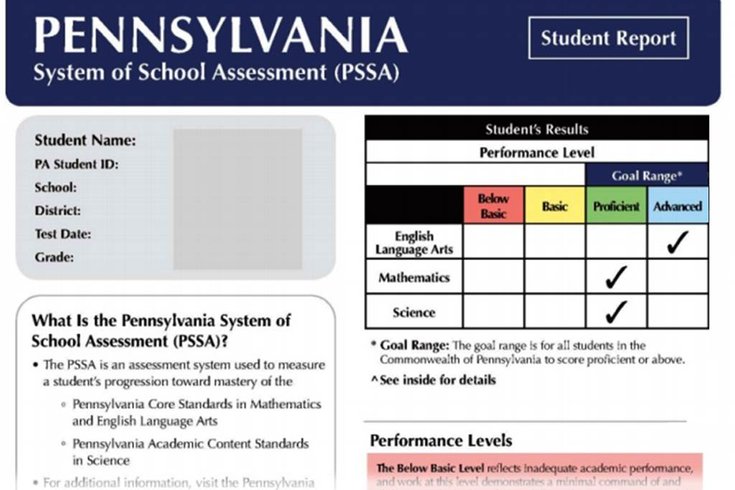
December 16, 2015
 ./Pennsylvania Department of Education
./Pennsylvania Department of Education
All Pennsylvania students in grades three through eight take the PSSA tests.
Winter break is just days away for most students, and it is safe to say few will be thinking about standardized tests, like Pennsylvania’s PSSAs, during their vacations
Which makes it prime time for a pop quiz … for our readers.
At the end of this article you'll find five questions (plus one for extra credit) originally included in sample tests posted on the Pennsylvania Department of Education’s PSSA site. The questions begin with third grade math and progress to seventh grade math. The bonus is a question from the eighth grade science test.
The PSSA – officially the Pennsylvania System of School Assessment – has been the primary tool for evaluating students, their teacher and schools under the the federal government’s No Child Left Behind Act.
Last week, President Barack Obama signed into law the successor legislation, Every Student Succeeds Act, which will continue to rely heavily on standardized tests like the PSSA’s in evaluating education systems but will also take into account other factors determined by individual states.
The three-week window for the PSSA begins April 11. The mathematics and reading tests are taken by all students in grades three through eight. Fourth and eighth graders also take science tests.
In general, U.S. students are improving in math and science, according to a Pew Research Center study published in February, although they still rank middle-of-the-pack internationally.
Among younger children, the future looks brightest. The Pew report cites the results of Trends in International Mathematics and Science Study, a test administered every four years and most recently in 2011, that shows U.S. fourth graders ranked eighth out of 50 countries in math and seventh out of 50 in science.
That’s the good news.
The bad news: For most who will take the following quiz, school days are over, maybe even ancient history. So presumably they were students at a time when Americans were less proficient in math and science than they are now.
Answers to the following questions are at the end of the article.
1. Third Grade Math:
Carla has a list of three numbers.
– Carla’s numbers are in order from least to greatest.
– The first number in her list has the least tens.
– Every number in her list has fewer tens than ones
Which list of numbers could be Carla’s list?
A. 125 146 153
B. 127 145 234
C. 158 176 245
D. 168 235 224
2. Fourth Grade Math:
Graham practiced piano for 135 minutes this morning. He practiced for 65 more minutes this afternoon. Altogether, Graham practiced 10 times longer today than he practiced yesterday. How many minutes did Graham practice piano yesterday?
A. 2
B. 20
C. 200
D. 2000
3. Fifth Grade Math:
Martha makes the statement shown below:
When multiplying two whole numbers that end in zeros, the product always has the exact same number of zeros at the end as the number of zeros from the end of the two numbers combined. For example, the product of 80 × 400 has exactly three zeros at the end since 80 ends in one zero and 400 ends in two zeros.
Which expression proves Martha’s statement is not correct?
A. 10 × 100
B. 20 × 200
C. 30 × 400
D. 40 × 500
4. Sixth Grade Math
An art teacher makes a supply package containing sheets of red paper and sheets of green paper for each student in a class.
– There are 84 sheets of red paper and 96 sheets of green paper available for the packages.
– Each package has the same number of sheets of red paper.
– Each package has the same number of sheets of green paper.
– The maximum number of packages are made.
– There are no sheets of paper remaining.
What are the maximum number of packages that can be made and the numbers of sheets of red paper and green paper in each package?
A. 6 packages with 14 sheets of red paper and 16 sheets of green paper
B. 12 packages with 12 sheets of red paper and 12 sheets of green paper
C. 12 packages with 7 sheets of red paper and 8 sheets of green paper
D. 24 packages with 3 sheets of red paper and 4 sheets of green paper
5. Seventh Grade Math:
Keyana put 0.83 liter of water into a bucket. Matt put 0.98 liter of water into another bucket. When they combined their water into a bigger bucket, 10% of the water spilled out. The water they collected had a weight of 1.021 kilograms per liter of water. The expression shown below represents the weight, in kilograms, of the water in the bigger bucket.
[0.9(0.83 + 0.98)] × 1.021
Rounded to the nearest thousandth, what is the weight, in kilograms, of the water in the bigger bucket?
A. 1.663
B. 1.748
C. 1.763
D. 1.848
EXTRA CREDIT
Eighth Grade Science:
Which statement best explains the importance of fossils to scientists?
A. Fossils show how animals viewed their surroundings, so scientists know more about past animals.
B. Fossils show what color animals once were, so scientists know more about what they ate.
C. Fossils show where animals once lived, so scientists know more about the environment and how it has changed.
D. Fossils show that animals lived in the same location today as they once did, so scientists know more about today’s environment.
Answers:
1. B 2. B 3. D 4. C 5. A
Extra Credit: C